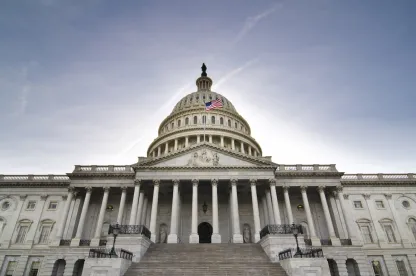The “Families First Coronavirus Response Act” (H.R. 6201) has passed the Senate and been signed by President Donald Trump.
This article discusses the paid Family and Medical Leave Act (FMLA) and paid sick leave provisions of the Act.
The Act was revised slightly from the bill passed by the House of Representatives on March 14, 2020 (see our article, Employer Obligations Under the Proposed Families First Coronavirus Act (H.R. 6201)).
Employers and Employees Covered
Both the paid FMLA and paid sick leave provisions apply only to private employers with fewer than 500 employees and certain public employers.
Both provisions allow an employer of an employee who is a healthcare provider or an emergency responder to elect to exclude the employee from the application of these two provisions.
In addition, they both allow subsequent U.S. Department of Labor regulations to exempt small businesses with fewer than 50 employees when the provision would jeopardize the viability of the business as a going concern.
FMLA Expansion for COVID-19
The Act amends the FMLA to allow an employee who is unable to work (or telework) to take leave due to a need to care for the employee’s son or daughter (under 18 years of age) if the child’s elementary or secondary school or place of care has been closed, or the childcare provider is unavailable, due to a “public health emergency.” A public health emergency means an emergency with respect to COVID-19 declared by a federal, state, or local authority.
Unlike the original bill, the closure of the child’s school or childcare is the only reason allowed under the added FMLA provisions, and the only reason allowed for paid leave under the FMLA.
Paid Sick Leave for COVID-19
The Act also adds a paid sick leave obligation. Employers with fewer than 500 employees must immediately make available 80 hours of paid sick leave for full-time employees (or the equivalent of the average number of hours over two weeks for part time employees) for the following reasons (which are slightly different than in the original bill):
- The employee is subject to a federal, state, or local quarantine or isolation order related to COVID-19.
- The employee has been advised by a healthcare provider to self-quarantine due to concerns related to COVID-19.
- The employee is experiencing symptoms of COVID-19 and seeking a medical diagnosis.
- The employee is caring for an individual who is subject to an order as described in subparagraph (1) or has been advised as described in paragraph (2).
- The employee is caring for their son or daughter if the school or place of care of the son or daughter has been closed, or the childcare provider of the son or daughter is unavailable, due to COVID-19 precautions.
- The employee is experiencing any other substantially similar condition specified by the Secretary of Health and Human Services, in consultation with the Secretary of the Treasury and the Secretary of Labor.
Amount of Pay
Under the FMLA provisions, when leave is needed due to a school or day care closure, the employer can provide the first 10 days of leave unpaid, then subsequent absences for this reason must be paid at 2/3 the employee’s regular rate of pay. The Act includes a cap of $200 a day and $10,000 in aggregate. If the first 10 days are unpaid, an employee may elect to substitute any accrued vacation leave, personal leave, or medical/sick leave for the unpaid leave.
Paid sick leave is paid at the employee’s regular rate, but it too is capped: $511 per day and $5,110 in the aggregate for a use described in paragraph (1), (2), or (3); and $200 per day and $2,000 in the aggregate for a use described in paragraph (4), (5), or (6).
Effective Date
Both the proposed FMLA changes and the proposed paid sick leave take effect not later than 15 days after enactment and would remain in place until the end of 2020.
Is leave job protected?
Yes, the Act offers job protection. However, the FMLA’s requirement that an employee be restored to the same or equivalent position after leave does not apply to an employer with fewer than 25 employees if the employee’s position no longer exists due to economic conditions or other changes in the employer’s operations that affect employment and are caused by the public health crisis during the period of leave.
The employer must make reasonable efforts to restore the employee to the same or an equivalent position, and if the reasonable efforts fail, the employer must make efforts to contact the employee and reinstate the employee if an equivalent position becomes available within a one-year period beginning on the earlier of (a) the date on which the qualifying need related to a public health emergency concludes, or (b) the date that is 12 weeks after the date the employee’s leave started.
Who pays for the sick time or leave?
Employers must pay the benefits, but they will receive a tax credit for doing so.
Is the paid sick leave in addition to current leave provided by the employer?
Congress removed a provision in the original bill that would have prevented employers from changing their current policies and benefits in response to the Act. But an employer may not require an employee to use other paid leave provided by the employer before the employee uses the paid sick leave available under the Act.
At what rate is the paid sick leave accrued?
The entire 80 hours of paid sick leave is available immediately. There is no accrual rate or period.
Which employees are eligible for these benefits?
The new FMLA provisions would apply to employees who have been employed for at least 30 calendar days. The usual FMLA requirements that the employee has been employed for a year, worked for at least 1,250 hours, and works in a location where there are 50 employees within a 75-mile radius would not apply.
The paid sick leave requirements would apply to all employees under covered employers.
What notice must an employee provide for leave?
The FMLA provisions require employees to provide the employer with “notice of leave as is practicable.”
The paid sick leave provisions state that after the first workday (or portion thereof) that an employee receives paid sick leave, an employer may require the employee to follow reasonable notice procedures in order to continue receiving the paid sick leave.
Does the 500-employee requirement refer to a location or company-wide?
The company (not just the location) must have fewer than 500 employees.
What about employees who work under multi-employer bargaining agreements?
Both the FMLA provisions and the paid sick leave provisions state that an employer who is a signatory to a multi-employer collective bargaining agreement may fulfill its obligations (consistent with bargaining obligations and the collective bargaining agreement) by making contributions to a multi-employer fund, plan, or program based on what paid leave each of its employees is entitled to while working under the agreement. The fund, plan, or program must enable employees to receive pay for the FMLA leave.
Is carryover required for unused emergency paid sick leave?
The paid sick provisions state that unused paid sick leave does not carry over from one year to the next.
Can an employee who takes emergency paid sick leave be required to find a replacement worker?
The paid sick leave provisions state that an employer may not require an employee to find a replacement worker when the employee takes such leave.
Must an employer pay out unused emergency paid sick leave if the employee separates from its employment?
An employer is not required to pay unused paid sick leave if an employee separates from employment.
Are employers with 500 or more employees obligated to provide paid sick or leave benefits?
They have no such obligation under this bill. However, they still must comply with obligations under state or local paid sick leave or paid family and medical leave laws and administer sick or paid time off or paid leave provided under company policies or collective bargaining agreements.
Many employers are actively assessing whether their existing paid sick and leave benefits adequately support employee needs in this unprecedented public health crisis and adjusting benefits as appropriate for their business and potential coverage under the proposed Families First Coronavirus Response Act.









 />i
/>i

